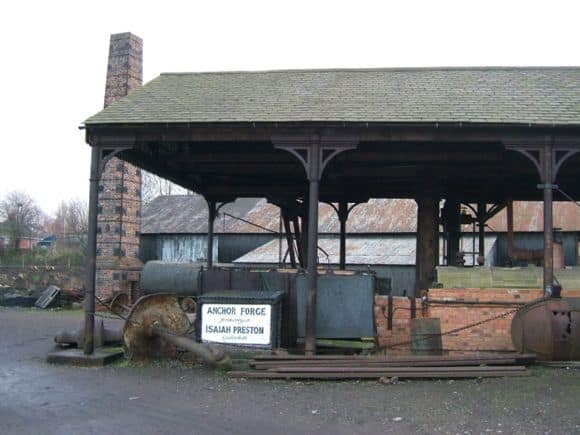In this episode the children visit the Anchor Forge and learn about the making of a very special anchor for a famous ship.
The Building
If you visit the museum, you’ll see the Forge as it might have looked in the 1920s.

Surprisingly, perhaps, for a region so far from the sea, for over a hundred years, anchor making was one of its most prominent industries and anchors for some of the most famous ships of the nineteenth and twentieth centuries, including Brunel’s ‘Great Eastern’, the ‘Titanic’ and the Royal Yacht, ‘Britannia’ were forged in the Black Country.
Where it all started
Following the introduction of the making of heavy chain in the region in the 1820s, Noah Hingley started making anchors at Netherton in 1838. In the 1970s the average weekly output was seven tons of a wide range of anchor types but the business closed in the spring of 1979 bringing to an end 140 years of anchor making in the region.
Forging 101
- The wrought-iron to be forged was heated in the furnace.
- ‘Waste heat’ from the furnace was drawn through the single flue of the large horizontal ‘Cornish’ boiler which raised steam to power the steam hammer.
- The furnace was originally coal fired but converted to oil firing in 1969.
- When the pieces of wrought-iron reached welding heat, the mass of metal was removed from the furnace and hammered to the required shape by the steam hammer.

The Titanic’s Anchor
The children in the episode find out that the Anchor Forge helped to make the anchor for the famous ocean liner The Titanic – let’s find out more!

“With sunshine glinting on harness and lighting up the festive ribbons, the horses responded gallantly to the call, and amid a scene of great animation, the white-coated giant left its Midland home to join the enterprise and the perils of those that go down to the sea in ships, and to carry across mighty oceans the evidence of the prowess of the workers of South Staffordshire.”
This is how the Dudley Chronicle reported the spectacle of the 16-ton anchor, destined for the White Star “Titanic” ocean liner, beginning its journey from Netherton to Belfast on Monday 1 May 1911.
Since the 1840s the landlocked Black Country region had been at the centre of the manufacture of anchors and marine chain. Noah Hingley & Sons Ltd, Netherton Ironworks, was one of the leading companies and had made anchors for the White Star shipping company before, for Titanic’s sister ship, the Olympic. The Titanic anchor, however, was the largest they had made for what would be the largest ship in the world.
According to the Dudley Chronicle, the work was supervised by Mr Osborne, manager of the cable department at the Netherton works. Gangs of men worked hard forging over a thousand feet of chain for the ship. It is well known that Hingley’s were not responsible for making the whole of the anchor however. Walter Somers Ltd of Mucklow Hill, Halesowen, forged the shank of the centre anchor because they owned more powerful steam powered hammers. Rogersons Ltd of Newcastle-upon-Tyne also cast the huge steel head of the anchor. Hingley’s however, made the remaining parts and assembled the whole together, with the main anchor measuring 18 foot 6 inches long and 10 foot 6 inches wide.
The Anchor on the Move

The first journey the anchor made was to the nearby Lloyd’s Proving House, where the anchor and cable were tested for strength and safety. Once the tests on the anchor and chain were satisfactorily completed, the anchor could begin its next journey, to the LNWR (London and North Western Railway) Goods Station in Tipton Road, Dudley.
To transport the anchor it was loaded onto a large heavy duty haulage cart, or dray, which was to be pulled by 8 horses, supplied by W. A. Ree, a sub-contractor to the LNWR, under the supervision of Chief Inspector Hobday of the LNWR. The journey would take the anchor through Netherton High Street, to Cinder Bank, onto Dudley town centre and down towards Tipton Road and the goods yard. With concern for the steep inclines en route Hingleys attached 6 of their own horses. A further 6 were made available to assist, which is why contemporary news reports quote the use of 20 horses. From the LNWR Goods Yard the anchor was transported by rail to Fleetwood in Lancashire, then by boat, the Duke of Albany, to Belfast. Its final journey to the shipyard was again by dray, pulled by horses.
The anchor’s journey to the Harland and Wolff shipyard in Belfast attracted public and media attention. The Dudley Chronicle reported that photographers were positioned at every vantage point, including E Beech from Cradley Heath, whose images were later sold as postcards and are the images we closely associate today with the anchor’s journey, and there was even a film made of part of the journey which would have been seen in cinemas.
According to the Dudley Chronicle the film footage was well received by cinema goers, especially finding the “spurt of the horses up the slope a stirring spectacle”. It would be amazing to see this footage, yet it’s almost certainly lost today.
As the horses, adorned with May-Day decorations, were being attached to the dray, onlookers began to gather, “until a crowd of a thousand actually witnessed the anchor’s departure”, according to the Dudley Chronicle.
One picture postcard shows some of the spectators in the street, as the horses begin to pull the anchor along on its journey.

The largest anchor in the world, leaving Netherton, was a spectacle in its own right, yet it was the sinking of the Titanic, on its maiden voyage in 1912, which overtook any previous publicity for the building of this impressive ocean liner.
The wreckage of the Titanic was only discovered on the seabed in 1985, 73 years after the ship sank, with underwater footage revealing the main anchor, still fixed on the bow. A replica of the anchor, made in 2010, is also on public display in Netherton town centre.
Activity: Draw a flag

The flag for the The Black Country features chain links – to represent the region’s proud history of forging. What might your family’s flag look like? You could design one which represents the things that are important to you?
Adventures Through Time is made with support from The Black Country Living Museum




 Apple Podcasts
Apple Podcasts Spotify
Spotify Google Podcasts
Google Podcasts Player FM
Player FM